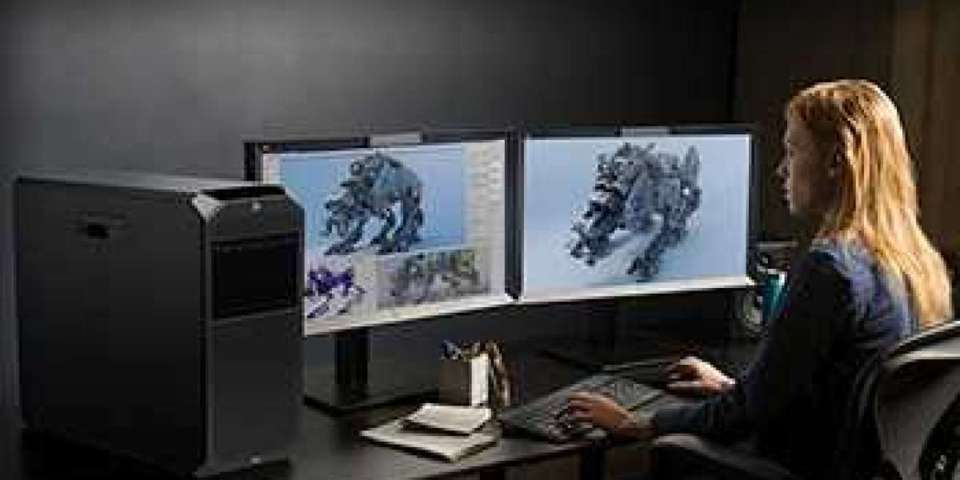What is a workstation computer?
A workstation computer is a high-performance computer system designed to handle complex tasks that require significant computing power, memory, and storage capabilities. It is typically used by professionals in fields such as engineering, architecture, graphic design, video editing, scientific research, and other computationally intensive industries.
Workstation computers are specifically optimized to provide superior processing power and multitasking capabilities, allowing users to run demanding applications and perform resource-intensive tasks simultaneously. They often feature powerful processors, large amounts of RAM (random access memory), high-speed storage options (such as SSDs), and advanced graphics processing units (GPUs) for tasks that involve heavy graphics rendering or scientific calculations.
One of the key differentiators of a workstation computer compared to a regular desktop or laptop is its reliability and stability. Workstations are built with high-quality components and undergo rigorous testing to ensure long-term stability and reliability. They are also often certified by software vendors to ensure compatibility with specialized software applications used in professional industries.
Workstation computers also offer expandability options, allowing users to add additional components such as graphics cards, storage drives, or specialized hardware depending on their specific requirements. They typically come with robust cooling systems to handle the heat generated by powerful components during prolonged usage.
The Importance of Cooling Systems for Workstation Computers
Cooling systems play a crucial role in workstation computers due to the high-performance components and intense workloads they handle. Here are some reasons why cooling systems are essential for workstation computers:
Heat Management:
Powerful processors, graphics cards, and other components generate significant heat when running resource-intensive tasks. Without effective cooling, the temperature inside the computer can rise to dangerous levels, leading to system instability, performance throttling, and potential damage to components. Cooling systems help dissipate heat, ensuring optimal operating temperatures and preventing thermal throttling.
Performance Optimization:
Excessive heat can negatively impact the performance of workstation computers. When temperatures rise, processors and other components may automatically reduce their clock speeds to prevent overheating, resulting in reduced performance. Adequate cooling allows components to operate at their maximum performance levels consistently, ensuring smooth and efficient operation.
Component Longevity:
Heat is a major factor contributing to component degradation over time. High temperatures can shorten the lifespan of critical components such as processors, graphics cards, and storage devices. Proper cooling helps maintain lower operating temperatures, which can extend the lifespan of these components, reducing the risk of premature failures and the need for frequent replacements.
System Stability:
Heat-related issues can cause system instability, leading to crashes, freezes, or unexpected shutdowns during intensive tasks. By maintaining optimal operating temperatures, cooling systems contribute to system stability and reliability, minimizing the risk of data loss or interruptions during critical work sessions.
Overclocking Support:
Overclocking, the practice of increasing the operating frequencies of components beyond their stock settings, can provide additional performance gains. However, this also increases heat output. Robust cooling systems are essential for managing the increased heat generated during overclocking, allowing users to push their systems further while maintaining stability.
Silent Operation:
Workstation computers are often used in professional environments where noise levels need to be minimized. Effective cooling systems, such as advanced CPU coolers and well-designed case fans, can dissipate heat efficiently without producing excessive noise. This ensures a quieter working environment, promoting focus and productivity.
To ensure effective cooling, workstation computers typically employ a combination of cooling components, including CPU coolers, case fans, liquid cooling solutions, and well-ventilated cases. It's important to consider the specific cooling requirements of the components being used and ensure proper airflow within the computer case to maintain optimal temperatures. Regular cleaning and maintenance of cooling systems are also essential to prevent dust buildup, which can impede airflow and compromise cooling efficiency.
The Future of Workstation Computers
The future of workstation computers is expected to be shaped by several emerging technologies and trends. Here are some potential developments that could have an impact:
Increased Performance:
Workstation computers will continue to benefit from advancements in processor technology, with more powerful CPUs and GPUs offering increased performance for handling demanding tasks. This will enable professionals to work with even larger datasets, complex simulations, and resource-intensive applications.
Artificial Intelligence (AI) Integration:
AI technologies are becoming increasingly prevalent across various industries. Workstation computers will likely incorporate AI capabilities, such as specialized AI processors or accelerators, to enhance tasks like data analysis, pattern recognition, and machine learning. This integration will enable workstations to process and analyze data faster, leading to more efficient workflows.
Virtual and Augmented Reality (VR/AR):
VR and AR technologies have the potential to transform the way professionals work. Workstation computers will play a crucial role in supporting VR/AR content creation, simulation, and visualization. As these technologies become more widespread, workstation computers will need to handle the high-performance requirements of rendering realistic virtual environments and delivering immersive experiences.
Cloud Computing and Remote Access:
Workstation computing is becoming more distributed, with the rise of cloud computing and remote access solutions. Professionals can access powerful workstation resources remotely, allowing for collaboration and flexibility. Workstation computers may leverage cloud-based rendering, virtualization, and streaming technologies to provide remote users with access to high-performance computing resources and software applications.
Modular and Scalable Designs:
Workstation computers may adopt more modular and scalable designs to accommodate evolving hardware requirements. This would allow professionals to easily upgrade or replace individual components, such as CPUs, GPUs, or storage, without having to replace the entire system. Modular designs can also support customization based on specific industry needs.
Enhanced Connectivity:
With the increasing reliance on data-intensive workflows, workstation computers will likely incorporate faster connectivity options. High-speed networking technologies like Thunderbolt, fiber-optic connections, or advancements in Ethernet standards will enable faster data transfer and collaboration between workstations, servers, and other devices.
Energy Efficiency:
Energy efficiency will continue to be a focus in workstation computer design. Efforts will be made to optimize power consumption and cooling systems to deliver high performance while minimizing energy usage and environmental impact.
Security and Privacy:
As data security and privacy concerns grow, future workstation computers will prioritize robust security features, such as hardware-level encryption, secure boot, and improved authentication methods. Workstations will need to meet stringent security standards to protect sensitive information and intellectual property.
These trends indicate that workstation computers will evolve to meet the increasingly demanding needs of professionals across various industries. The future holds exciting possibilities for enhanced performance, advanced technologies, and improved efficiency in workstation computing.
Conclusion
In conclusion, workstation computers are indispensable tools for professionals in fields that require high-performance computing. They are designed to handle complex tasks, intensive workloads, and resource-heavy applications. Cooling systems play a critical role in ensuring the optimal performance, longevity, and stability of workstation computers by managing heat generated by powerful components.
Looking to the future, workstation computers are expected to continue advancing in terms of performance, incorporating emerging technologies such as AI, VR/AR, and cloud computing. Modular and scalable designs will provide flexibility and upgradability, while enhanced connectivity options will facilitate seamless collaboration. Energy efficiency and security will remain important considerations in workstation computer design.
The future of workstation computers promises increased capabilities, improved productivity, and new possibilities for professionals in various industries. As technology continues to evolve, workstation computers will play a vital role in empowering individuals and organizations to tackle complex challenges and achieve their goals.



